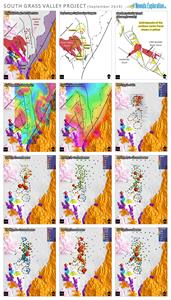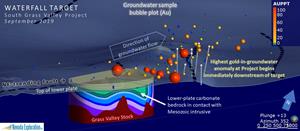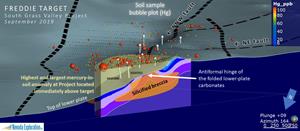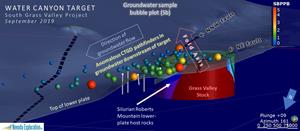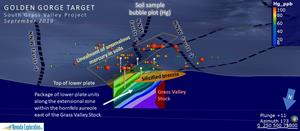Nevada Exploration Establishes District-Scale Potential and Increases Land Position at Carlin-Type South Grass Valley Gold Project, Nevada
RENO, Nev., Sept. 19, 2019 (GLOBE NEWSWIRE) -- Nevada Exploration Inc. (“NGE” or the “Company”) (TSX-V: NGE; OTCQB: NVDEF) is pleased to announce that, based on the results of its 2019 summer field program, it has updated and enlarged its geologic model for the mineral system at South Grass Valley (the “Project”), and that the Company believes the mineral system at the Project has the architecture and scale to support multiple Carlin-type gold deposits (CTGDs), with the potential to host an entire new district. Furthermore, NGE’s summer program resulted in a significant increase in geochemistry sample coverage across the Project, which has provided important data to prioritize specific targets for the Company’s next stages of exploration. NGE believes South Grass Valley is evolving as one of the most exciting new district-scale, Carlin-type projects in Nevada, and has staked an additional 1,200 hectares (3,000 acres) at the Project.
NGE’s CEO, Wade Hodges, discusses how the results of the 2019 summer field program have contributed to establishing the geologic setting and district-scale mineral potential at South Grass Valley: “When you look at Nevada’s largest Carlin-type districts, they’re very similar in terms of their geologic architecture. They are each made up of a thick package of favourable lower-plate host rocks punctuated by a large intrusive, proximal to the intersection of multiple regional-scale structures. It is the relationship between these features that provides the spectrum of specific geologic settings that lend themselves to various styles of Carlin-type mineralization – with generally higher grades found closer to the intrusive and lower grades seen further away.
“What we’re seeing at South Grass Valley is this exact architecture with the same corresponding set of prospective geologic settings. As we laid out in May, the objectives for our summer exploration program were to: (1) complete a number of additional diamond core drill holes to add stratigraphic and geologic information beyond the limits of our earlier drilling; and (2) increase the density of geochemistry samples across all areas of the Project for the purpose of selecting and prioritizing targets for detailed in-fill drilling.
“The results of our summer program have significantly improved our understanding of the geology across the Project, and we are now focusing our efforts on a handful of discrete targets prioritized directly on the presence of gold and CTGD pathfinders. Based on these results, we believe that the mineral system at South Grass Valley has the scale and range of geologic settings to support an entire new Carlin-type district, providing multiple opportunities for new discoveries. This is the type and quality of otherwise-blind exploration project that exists under cover beneath Nevada’s large valley basins – the exact type of project we’ve built Nevada Exploration to find, and here it is. Our job at South Grass Valley is to now shift our scale of investigation, zoom in, and advance each target according to its specific setting; and we look forward to sharing the next chapters of this program with our stakeholders.”
A DISTRICT-SCALE MINERAL SYSTEM
Driven by the additional geologic and structural data provided by the latest core holes, as well as new detailed mapping of the geology and structural features exposed along the margins of the project, the Company has updated and enlarged its geologic model for the mineral system at South Grass Valley. The Project is centred on a large Mesozoic intrusive, referred to in the literature as the Grass Valley Stock, at the intersection of a parallel series of NW fold axes and a major NNW structural corridor that cuts through a >500-metre-thick sequence of lower-plate bedrock. Each of NGE’s 11 core drill holes to date (spread out across a N-S distance of more than 3.5 kilometres) encountered significant CTGD-style alteration and trace-element mineralization, most significantly associated with a broad complex of flat lying blankets and/or high-angle structural conduits of silicification encountered in 8 of the 11 core holes. The Paleozoic carbonates are overlain by several unaltered Tertiary volcanic units some of which are believed to be related to the nearby Hall Creek Caldera. Drilling intersected silicified breccia boulders within a basal volcanic mudflow unit older than the nearby dated volcanics. The boulders are identical in alteration characteristics and trace-element compositions to breccia units encountered at depth in the Paleozoic carbonates. Based on these observations and a reconstruction of the Paleo surface, the Company believes that the mineralizing events at South Grass Valley occurred relatively close to the then paleosurface, and prior to 34 Ma, and that they were followed by deep incision of the paleo topography. For reference, the Cortez Hills mineralization has been dated at 35.7 Ma.
Together, the dominant geologic features at South Grass Valley – namely the intersection of major structural features within a thick package of folded, favourable lower-plate host rocks in a place where an intrusive has enhanced the local structural conditions for mineralization – represent a strikingly similar architecture to those that make up Nevada’s three largest Carlin-type districts: the Northern Carlin Trend, adjacent to the Little Boulder Basin and Goldstrike Stocks; the Cortez Trend, adjacent to the Mill Canyon Stock; and the Getchell Trend, adjacent to the Osgood Mountains Pluton. Nevada Exploration believes that this same combination of features at South Grass Valley provides an analogous range of geologic settings to those that host the significant Carlin-type mineralization in these districts.
Based on the geochemistry associated with the mineralization and alteration at the Project, NGE believes that the volume of hydrothermal fluids that passed through the structurally-prepared favourable host rocks at South Grass Valley contained a characteristic budget of gold and CTGD pathfinders. Furthermore, based on the placement of geologic features related to known events, NGE believes that the bounds for the timing of this hydrothermal activity is consistent with the sweep of magmatism associated with the CTGD mineralization at Nevada’s three largest Carlin-type districts. Lastly, based on the results of the wide-spread early drill holes, NGE believes that the scale of the mineral system defined by these features at South Grass Valley is consistent with the scale of the mineral systems associated with these major districts.
PRIORITY TARGETS FOR NEXT STAGES OF EXPLORATION
To prioritize specific geologic settings (targets) for the next phases of work at South Grass Valley, as part of its 2019 summer field program Nevada Exploration collected significant additional geochemistry samples, including: more than 100 groundwater samples from 54 new purposed-drilled bore holes, for a new combined total of 377 groundwater samples; 922 new soil samples, for new combined total of 1,854 soil samples; and 978 metres of new core samples from drill holes SGVC009, SGVC010, and SGVC011, for a new combined total of 3,654 metres of core samples.
Since sharing its last Project update on August 1, 2019, NGE completed its final drill hole of its summer program, SGVC011, to a depth of 864 metres. SGVC011 was the first hole to successfully drill through the bottom of the intense, multi-phase silicified breccia seen at the bottom of many of the earlier drill holes. In this location, the thickness of the silicified breccia zone was approximately 200 metres. The core samples from this zone, marked by significant secondary pyrite, contained the highest grade-thicknesses for Arsenic, Mercury, Thallium, and Antimony, seen to date at the Project. Full drill results from the summer drill holes, including downhole strip logs with assays for gold and CTGD pathfinders plus core photos, are available at: http://www.nevadaexploration.com/_resources/South-Grass-Valley-Data-September-19-2019.pdf.
The additional geochemistry data have improved the Company’s data coverage across the project and provided a new scale of resolution. The hydrogeochemistry data have established that the N-S zone of highly anomalous gold and CTGD pathfinders in groundwater is most intensely focused along the margins of the Grass Valley Stock. The larger soil-geochemistry dataset has extended the anomalous mercury in soils northward along the axis of the major NNW structural corridor, while also highlighting the magnitude of the larger, more continuous mercury-in-soils feature located immediately above the shallow projection of the favourable geologic features encountered at deeper depths in nearby drill holes. Lastly, the latest drilling has extended the intense alteration features in bedrock associated with highly anomalous CTGD pathfinders in bedrock along a now-combined strike length of more than 3,500 metres, consistent with the margins of multiple, overlapping CTGD footprints.
By integrating the latest geochemistry data with its updated geologic model for the Project, NGE has identified at least four discrete targets. Each target is defined by a specific set of geologic conditions known to host large CTGDs, and each is supported by anomalous geochemistry in at least two sampling mediums. With multiple targets across a district-scale mineral system that is comparable in size to those associated with Nevada’s major Carlin-type districts, such as the Northern Carlin Trend, Nevada Exploration believes South Grass Valley has the potential to support multiple CTGDs. Based on these results, the Company has significantly increased its land position by staking 154 new claims, covering an additional 1,200 hectares, for a new total of 5,750 hectares, representing a district-scale land package measuring approximately 12 kilometres north-south by 5 kilometres east-west.
A photo accompanying this announcement is available at https://www.globenewswire.com/NewsRoom/AttachmentNg/b33b42fa-e79f-4590-8bd2-f0cbc6a722de
NGE has included short descriptions below to introduce each of the four target areas to its stakeholders. In the coming weeks, the Company expects to provide more detailed information about the targets and the Company’s plans to advance them.
WATERFALL TARGET
The concept to be tested at the Waterfall target is that of fracture-controlled, high-grade, oxide gold mineralization within hornfelsed lower-plate carbonates in contact with the Mesozoic intrusive, emplaced along SE-plunging fold axes at the intersection of a NE-trending fault. Deposit analogues include Betze-Post and Fourmile. This relatively shallow target sits immediately upstream from the highest gold in groundwater seen at the Project.
A photo accompanying this announcement is available at https://www.globenewswire.com/NewsRoom/AttachmentNg/03ab8352-8306-416e-ad11-4db5cc2a7f7f
FREDDIE TARGET
The concept to be tested at the Freddie target is that of oxidized silicified breccia-hosted gold mineralization in the up-plunge extension of the CTGD-trace-element-bearing breccias intercepted in holes SGVC009 and SGVC011. The targeted style of mineralization is analogous to Goldrush. Freddie is located at the intersection of a NNW district-scale fault and a NE-trending fault along the antiformal hinge of the folded lower-plate carbonates, known to contain silicified breccias. The drilling target projects under shallow cover and is coincident with both the N-S zone of anomalous gold in groundwater, as well as the largest and highest mercury-in-soils anomaly at the Project.
A photo accompanying this announcement is available at https://www.globenewswire.com/NewsRoom/AttachmentNg/7bad00d7-8f2e-405c-8868-9eb4279c1319
WATER CANYON TARGET
The concept to be tested at the Water Canyon target is that of the classic Carlin model, with a nearby upper-plate cap rock along a major fold axis, providing traps for hydrothermal fluids within favourable Silurian Roberts Mountain lower-plate host rocks. Water Canyon is located at the intersection of a NNW lineament and a NW fault fabric, as well as a NE fault, within the potential pressure shadow extending south of the Grass Valley Stock, to the east of historic adit and trench workings in the exposed bedrock. The target is supported by anomalous CTGD pathfinders in groundwater as well as anomalous mercury in soils.
A photo accompanying this announcement is available at https://www.globenewswire.com/NewsRoom/AttachmentNg/b33b42fa-e79f-4590-8bd2-f0cbc6a722de
GOLDEN GORGE TARGET
The concept to be tested at the Golden Gorge target is that of high-grade, narrow, steep, calc-silicate- hosted gold mineralization within the relay zone between major, parallel NNW faults, analogous to the
Deep Star-style mineralization associated with the Post-Genesis fault in the northern Carlin Trend. Golden Gorge is located along an extensional zone within the hornfels aureole east of the Grass Valley Stock, providing potentially favorable rock preparation. The target sits above a lineament of anomalous mercury in soils within the N-S zone of enriched gold in groundwater, and is supported by the Company’s recent drilling where hole SGVC005 encountered extensive breccia units with intense silicification, marbleization, and anomalous CTGD pathfinders.
A photo accompanying this announcement is available at https://www.globenewswire.com/NewsRoom/AttachmentNg/a0648ff0-fe37-47bb-9bad-2f14739d948e
About South Grass Valley
NGE’s South Grass Valley Project is a covered (blind) gold exploration project located approximately 50 kilometres south-southwest of the Cortez complex operated by Nevada Gold Mines (Barrick Gold Corp. and Newmont Mining Corp. joint venture) and Barrick Gold Corp.’s latest Fourmile discovery, within the specific region of north-central Nevada known to host world-class CTGDs. NGE originally identified and staked the Project based on elevated concentrations of gold and CTGD pathfinder elements in groundwater that the Company discovered during a generative basin-scale hydrogeochemistry-supported exploration program. Since acquiring the Project, NGE has completed: an in-fill borehole groundwater sampling program, detailed air magnetic and gravity geophysics surveys, a soil geochemistry sampling program, and 11 wide-spaced stratigraphic orientation diamond core holes.
As NGE continues to advance the Project, per NI 43-101, 2.3(2), the Company must remind its stakeholders that the Project remains an exploration target for which the potential quantity and grade of any mineral resource is still conceptual in nature. There has been insufficient exploration to define a mineral resource, and it is uncertain if further exploration will result in the target being delineated as a mineral resource.
About Nevada Exploration Inc.
NGE is an exploration company advancing a portfolio of new district-scale gold exploration projects along Nevada’s Battle Mountain-Eureka (Cortez) Trend. NGE is led by an experienced management team that has been involved in several major discoveries in Nevada, including the discovery of Lone Tree and Rabbit Creek (part of the Twin Creeks Mine). NGE’s team has spent the last decade integrating the use of hydrogeochemistry with conventional exploration tools to develop a Nevada-specific regional-scale geochemistry exploration program.
With new proprietary technology, NGE has completed the world’s largest groundwater sampling program for gold exploration, collecting approximately 6,000 samples to evaluate Nevada’s covered basins for new gold exploration targets. To advance follow-up targets, NGE has overcome the high drilling costs that have previously prohibited the wide-spread use of drilling as a prospecting tool by developing its Scorpion drill rig, a small-footprint, truck-mounted, small-diameter RC drill rig specifically tailored to the drilling conditions in Nevada’s basins (analogous to RAB drilling in other parts of the world).
By integrating hydrogeochemistry and early-stage low-cost drilling with conventional exploration methods, NGE is overcoming the challenges and radically reducing the costs of exploring in Nevada’s covered basins, and is taking significant steps to open this important new search space up for district-scale exploration.
For further information, please contact:
Nevada Exploration Inc.
Email: info@nevadaexploration.com
Telephone: +1 (604) 601 2006
Website: www.nevadaexploration.com
Neither the TSX Venture Exchange nor its Regulation Services Provider (as that term is defined in the policies of the TSX Venture Exchange) accepts responsibility for the adequacy or accuracy of this release.
Wade A. Hodges, CEO & Director, Nevada Exploration Inc., is the Qualified Person, as defined in National Instrument 43-101, and has prepared the technical and scientific information contained in this News Release.
Cautionary Statement on Forward-Looking Information:
This news release contains “forward-looking information” and “forward-looking statements” (collectively, “forward-looking information”) within the meaning of applicable securities laws, including, without limitation, expectations, beliefs, plans, and objectives regarding projects, potential transactions, and ventures discussed in this release.
In connection with the forward-looking information contained in this news release, the Company has made numerous assumptions, regarding, among other things, the assumption the Company will continue as a going concern and will continue to be able to access the capital required to advance its projects and continue operations. While the Company considers these assumptions to be reasonable, these assumptions are inherently subject to significant uncertainties and contingencies.
In addition, there are known and unknown risk factors which could cause the Company’s actual results, performance or achievements to be materially different from any future results, performance or achievements expressed or implied by the forward-looking information contained herein. Among the important factors that could cause actual results to differ materially from those indicated by such forward-looking statements are the risks inherent in mineral exploration, the need to obtain additional financing, environmental permits, the availability of needed personnel and equipment for exploration and development, fluctuations in the price of minerals, and general economic conditions.
A more complete discussion of the risks and uncertainties facing the Company is disclosed in the Company’s continuous disclosure filings with Canadian securities regulatory authorities at www.sedar.com. All forward-looking information herein is qualified in its entirety by this cautionary statement, and the Company disclaims any obligation to revise or update any such forward-looking information or to publicly announce the result of any revisions to any of the forward-looking information contained herein to reflect future results, events or developments, except as required by law.
